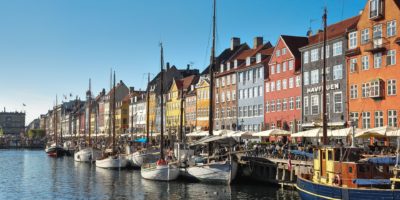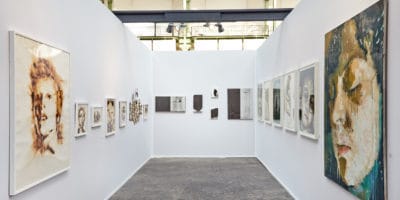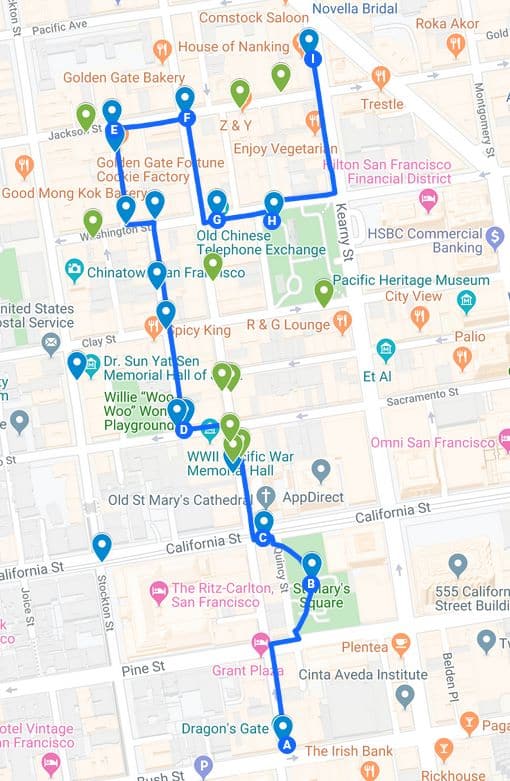Best Way to Visit Chinatown – (a walk through Chinatown)
The best way to see Chinatown is to do a walk through it
What is Chinatown San Francisco?
What to see and do in Chinatown?
Best places for food in Chinatown?
Best shopping in Chinatown?
Where to park?
What about the Chinatown’s New Year’s Parade?
Chinatown map
Chinatown Highlights
What is Chinatown
Chinatown San Francisco is unique. It was built immediately after the devastation of the 1906 earthquake had destroyed virtually 100% of the buildings the Chinese had been living in.
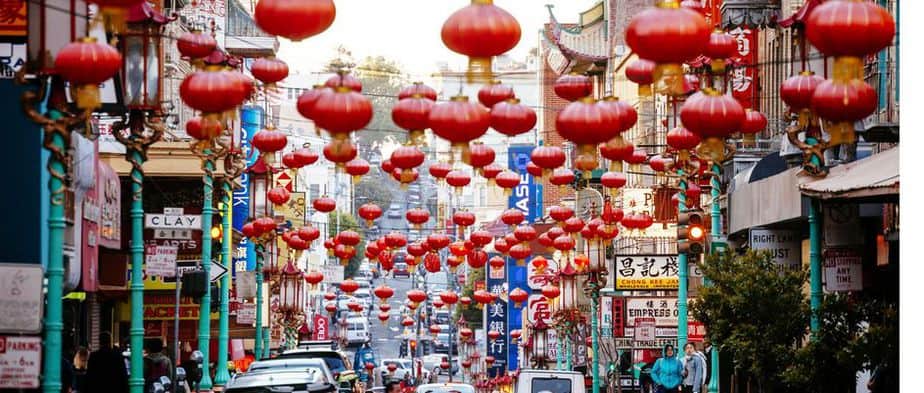
Grant Avenue – Chinatown San Francisco
Prior to 1906 the Chinese were discriminated against in San Francisco and by law, had been forced to live in a fifteen-block area just west of Portsmouth Square. It was a hotbed of prostitution and opium use. Immediately after the 1906 earthquake, the people in control of San Francisco, mayor and city council, were planning to change the law and force all Chinese to move 5 miles south to get them away from the central city. Even without building permits, several Chinese merchants rebuilt, but added large decorative Chinese architecture to the outsides of the new buildings. While the stated purpose was to ‘attract tourists, many thought it was a good way to keep non-Asians from wanting to buy the buildings. No matter what the story, the idea spread and a few years after 1906, Chinatown was built the way it looks today.
Map of Chinatown Walk
See detailed Interactive Printable Map of this walk on Google
What to see and do in Chinatown
Visiting Chinatown is the perfect tourist thing to do in San Francisco. The Chinatown neighborhood is compact just 15 city blocks. This makes it the perfect place to walk around to see. Add the narrow streets and pedestrian alleys and walking is really the only way to visit Chinatown.
Probably the number one thing to do and see in Chinatown is just the feel of it walking around. It is as close as most people get to how China feels. As you wander Grant, Stockton and the side streets, you will get the biggest immersion in Chinese culture outside of Asia. Yes, there are the Chinese tourist bazaar shops, but also the Chinese butcher (much different), Chinese produce (again, much different), herb stores, the tea shops, dozens of Chinese restaurants (which have to compete for real Chinese customers, not just tourists). Stockton Street is likely to be 90%+ Chinese pedestrians on the streets.
There are things to see like the Dragon’s Gate, the Fortune Cookie factory, Taoist Temples, Buddha statues – (a list of Chinatown highlights is below). Make sure you eat some food in Chinatown. Buy a Chinese ‘trinket’ you would not find at home. Go in the alleys and feel that even they are vibrant with people, work and culture.
If you have time, take the walk outlined in this article. It will be one of the highlights of your visit to San Francisco.
Where to park in Chinatown
There are two well placed parking lots right next to Chinatown. If you want to park near the Dragon’s Gate entrance to Chinatown, then the Sutter Stockton Garage is best. If you want to park more toward North Beach, then the Portsmouth Square Garage would be good.
The Sutter Stockton Garage can be entered from either Stockton or Bush Streets. When you leave the lot to visit Chinatown, use the Bush Street side. You are only a half block from the Chinatown entrance. This is a great place to park if you are going to spend time in the downtown, Union Square area, before or after visiting Chinatown.
The Portsmouth Square Garage is underground, below Portsmouth Square Park. The entrance for cars is on Kearney Street. To visit Chinatown, take the elevator to the top floor and you will exit in the park – just walk up the hill to be on Grant Avenue.
The Chinatown Walk
Time/Length – One hour to 90 minutes – 1.2 miles (2 km)
Highlights on Chinatown walk
• Dragon’s Gate
• St. Mary’s Square
• Old Saint Mary’s Cathedral
• California Ave Cable Car
• First Building in Chinatown
• Ritz Carlton Hotel
• Sun Yat Sen Memorial
• Chinese High School
• Waverly Place
• Fortune Cookie Factory
• Opium Dens
Dragon’s Gate

Dragon’s Gate Entrance to Chinatown
We start our walk at the Dragon’s Gate to Chinatown on Grant Avenue. While the gate looks as old as all the buildings, it was not installed until 1971, after almost 20 years of fighting over it. The Gate quickly became a photo favorite of tourists. And, the Dragon’s Gate, along with the two larger buildings on the corner of grant Avenue and California Avenue, are the photos that are usually used to promote San Francisco’s Chinatown.
The shops in this first block are totally tourist traps and should be ignored. At Pine Street we turn right, downhill for 50 feet (15 meters) until getting to St Mary’s Square.
St. Mary’s Square
Entering the Square, you will find a statue of Sun Yat Sen done by one of San Francisco’s more prolific sculptures, Beniamino Bufano. It is another example of a quiet place in a busy city.
As we exit the Square for the other side on California Avenue, you will notice this is one of the Cable Car streets in San Francisco. The California Avenue Cable Car Line is the oldest of the three lines still operating. Unlike the others, this Line runs straight up and down California Avenue. I personally like riding the others because of the occasional narrow neighborhood streets and turns, but the California Avenue Line does make the great climb up to the top of Nob Hill – and goes all the way to Van Ness Boulevard. So, it is a nice ride, plus from the top of Nob Hill you have great views in several directions.
Grant Avenue and California Avenue

Grant Avenue – Chinatown
Our walk goes uphill ½ block, back up to Grant Avenue. This is the most famous corner of Chinatown with the iconic photo of the Cable Car in front of the Chinese building. (the photo we started this article with.).
Old St Mary’s Cathedral

Old St. Mary’s
Across Grant Avenue is an odd addition to Chinatown, Old St Mary’s Cathedral. It is an old brick Catholic church Old St Mary’s was built in 1854, just eight years after Captain Montgomery planted the US flag in nearby Portsmouth Square declaring San Francisco part of the United States. The church faces California Avenue as it was the major road to the top of Nob Hill (back then called California Hill – renamed later due to the fame and fortune of the people who moved to the top of the hill in the 1870s and 1880s.)
During the 1906 earthquake, which destroyed virtually all the buildings in what is now Chinatown, Old St. Mary’s Cathedral was gutted by fire, but its brick exterior was not brought down by either the shaking of the quake nor the heat of the fire ( which was so hot it melted the church bells.) By 1909, the church had been restored and put in use. Today it sits on the prime corner of Chinatown.
California Cable Car Line
Leland Stanford built the California Cable Car Line. Stanford was; the first Republican Governor of California in 1861, President of both the Southern Pacific Railroad and the Central Pacific Railroad (and one of the men who put the gold spike in the connection of the first transcontinental railroad), and founder of Stanford University on the site of his Palo Alto, California horse stock farm (which is why the nickname for Stanford University is “the farm”.) Stanford opened the California Cable Car Line in 1878 and he moved to the mansion on California Avenue that he built one block from the top of Nob Hill (today the Stanford Court Hotel sits on the property as the Stanford mansion burned down in 1906.)
Nob Hill
If you are feeling strong and adventurous, and have extra time for an excursion, walking up some or all of Nob Hill can be a rewarding experience.
Ritz-Carlton

Ritz-Carlton Hotel – Nob Hill
While it looks like a huge climb (and it is steep), it is really only 3 blocks up from Grant Avenue. If you can only make it to the first block, you will be rewarded with a fabulous building on the corner of California Avenue and Stockton street, it was built in 1909, just 3 years after the earthquake. It was the headquarters of the Metropolitan Life company until 1991 when it opened as the Ritz-Carlton Hotel. You might notice that this section of Stockton Street is very quiet. That is because the main Stockton Street was tunneled under Nob Hill in 1914, leaving the section, with the Cable Car line on the top.

Stockton Street tunnel with Stockton Street on top
If you have the legs to go up one more block, you will get to one of the most interesting corners in San Francisco, the corner of California Avenue and Powell Street. Here you will find the only place in San Francisco where two cable car lines cross with a full time ‘traffic cop’ in a booth to make sure that both lines don’t try to get to the top of the hill at the same time.
Just across Powell is the Stanford Court Hotel. This was the site of Leland Stanford’s mansion from 1880 until 1906 when it burned to the ground.
My first job in San Francisco was in an office tower on St Mary’s Square. And for lunch, we mostly went to Chinatown – great food, cheap prices. But sometimes, we walked up Nob Hill for two blocks and caught the Powel and Mason Cable Car Line to Fisherman’s Wharf for a seafood lunch. Hopefully, you will add that to your visit to San Francisco.
Ok, you’ve done two blocks to the top, only one block left to go. If you have the energy, it is worth it.
The Top of Nob Hill

Original Fairmont Hotel – Nob Hill
At the top of Nob Hill, you will get the original Fairmont Hotel. It was built in 1905. The interior was gutted with fire from the earthquake in 1906. Then it was remodeled and opened in 1907.
Across California Avenue is the Mark Hopkins Hotel with the famous nightclub, ‘Top of the Mark’.
You will find one mansion, the Flood Mansion. It is the only mansion left from the dozens that were on Nob Hill prior to the 1906 earthquake and fire. Despite its large size, it was just an average sized mansion on Nob Hill at that time.

Old Flood Mansion – Nob Hill
Go past the Flood Mansion (now the Pacific Union Club), into Huntington Park. You get a nice look at Grace Cathedral. After the 1906 fire destroyed his mansion, Charles Crocker, railroad and banking tycoon, donated his land to the church. While the cornerstone of the foundation was laid in 1910, final completion was not finished until 1964. Martin Luther king Jr. gave the sermon at the church consecration in March of 1965.
I have always wondered what life was like for the thirty years in San Francisco prior to the 1906 earthquake. With the gold rush money and then the silver rush money, plus all the trade starting up with South America and Asia, the new rich were being ‘minted’ in San Francisco. When you add the completion of the transcontinental railroad, San Francisco became one of the most vibrant cities in America. And at the same time a huge influx of Chinese are entering California, but are severely discriminated against. Chinatown exists because of the discrimination, where the City of San Francisco limited property ownership by Chinese to a 15 square block area. When you add the fact that at this point 90% of the Chinese allowed into the US were male, it led to a great deal of prostitution, gambling and opium dens. In the fifteen square blocks of San Francisco there were dozens of opium dens, brothels and gambling halls. With the vices came bribery, corruption and gang fighting.
Yet, Chinatown was only two blocks down Nob Hill on California Avenue from the opulent Stanford Mansion. When I read some of the old newspapers from back then, San Francisco really was the Wild West. Non-Chinatown areas had names like; the Barbary Coast, Baghdad by the Bay, and Butchertown (now Dogpatch). When I watch a cable car go through Chinatown, I try to imagine, men in suits and women in gowns coming from the Financial District going up Nob Hill to go home and looking out into Chinatown. San Francisco was high contrast then and it still is today.
Far East Cafe
If you climbed up to the top of Nob Hill, it is time to go back down to California Avenue and Grant Avenue. Our walk heads north on Grant Avenue. One of my favorite lunch places is the Far East Cafe which opened in 1920 with ornate wall coverings which are still there. If you can get a ‘walled-in’ booth take it. I am sure those booths have lots of stories to tell from the last 100 years.
On the corner, across the street from each other, are the Caton Bazaar and the Bargain Bazaar. These two are typical Chinatown ‘Chinese junk’ stores. They are two of the better ones. Great to go in and find out how much crazy stuff you can buy for $20.
First Chinese Baptist Church
We turn left on Sacramento Street and head uphill to an alley named Waverly Place. On this corner are two interesting places. Clarion is a music instrument store with a very unusual collection. Worth going in to see. Across the alley is The First Chinese Baptist Church. It was started in 1880 in this very building.
Waverly Place
Continuing down the block, there is a great Chinese acupuncture store. Also please note the two different flags on the top of many of the buildings. About half of the flags are for Taiwan and the other half for mainland China. This difference is a source of some tension in Chinatown.

Tin How Temple altar
About halfway down the block is the building that contains the Tin How Temple. If you have time, it is well worth a visit. It was established in 1852 and it is a Taoist Temple to the Chinese Sun God Mazu (Empress of the Sea, which is what Tin How means in Cantonese.) The temple is housed on the top floor and they do allow visitors. The photo here is of the temple altar.
Also, if you read the signs on many of the doors on Waverly Place and many of the side streets and alleys, you will note a number of family Associations of Benevolent Associations. These are places to help new immigrants from different parts of China. In the past, some have also been the source of some unsavory practices.
Our walk crosses Clay Street as we stay on Waverly Place. Clay Street, which also heads up Nob Hill, was the street where the cable car was invented, with the inventor getting a patent and become rich quite quickly in the 1870s. As you can see, the Clay Street Cable Car is gone. At one point there were 23 different cable car lines in San Francisco. It turns out that an electric streetcar cost about 10% of what operating a cable car system costs – this is why almost all cable cars disappeared.
Sun Yat Sen Memorial
A possible detour is to go up Clay Street to Stockton Street and turn left.
A couple of buildings down is the Dr. Sun Yat Sen memorial. He is recognized as the Father of Modern China as he was instrumental in creating The People’s Republic of China and was the first President. He spent time in 1911 in San Francisco fundraising for his campaign to overthrow the Qing Dynasty. And, after over twenty years of struggle, by the end of 1911, the revolution was completed and Sun Yat Sen was the first President of the Republic of China.
Back down on Waverly Place, on the next block, I want you to take in the feeling of Chinatown and stores as you past. They have been operating similar to this for 50 years. But 100 and 150 years ago, Waverly Place was the main prostitution street of Chinatown with five brothels.
As we exit Waverly Place onto Washington Street, you should note the Golden Dragon Restaurant. In 1977 a Tong gang war broke out and five people were massacred in the restaurant. It was one of the reasons the city worked hard to reduce gangs in Chinatown, but it even in 2015, there have been problems.
Our walk goes up Washington Street to Ross Alley. The alley is quite narrow at this end and looks pretty rough, but it has a sign saying Ross Alley so you can’t miss it. There are even some plaques in the concrete pointing out that this alley is part of the Barbary Coast Trail. Coming here late at night might be safe, but wouldn’t feel like it.
Fortune Cookie Factory
The Fortune Cookie Factory is located about 100 feet (30 meters) into the alley. It is a fun place for a short stop and go inside. Even if there are 20 people in line outside, get in line (it moves fairly quickly.) They often give out flat fortune cookies as samples. But I always buy a bag of fortune cookies to munch on for the rest of the day. Feels fun to open one fortune cookie after another.

San Francisco Fortune Cookie Factory
We exit Ross Alley onto Jackson Street. Our walk officially goes downhill, but slightly uphill across the street is a small alley now named Duncombe Court. In the 1880s, there were five opium dens officially identified by the city as being in the alley, as well as two gambling houses. The next alley down the street, now called Jason Court had 7 brothels on it.
When we get back down to Grant Avenue, we turn right and walk down Grant Avenue for a block. There are two events on Grant Avenue which are not common anywhere else.
Chinese New Year’s Parade

Chinese New Year’s Parade
One is the Chinese New Year Parade. Based on a lunar calendar this parade tends to be in late January or February each year. I have never gone, but I have seen people practicing dance moves for the parade in the streets of Chinatown in the weeks before. (More on the parade near the end of this article.)
Green Street Funeral Parade
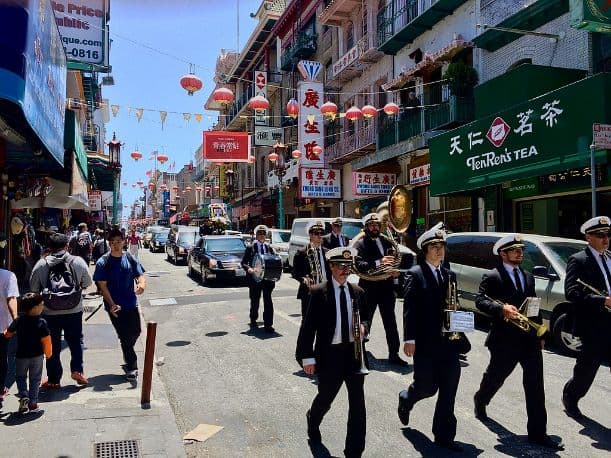
Green Street Mortuary funeral parade and band
In a tradition a bit like New Orleans has, some Chinese funerals include a parade. This is often a parade to the places that the person being buried would visit on a regular basis during their lifetime. And most often, it includes a few blocks down Grant Avenue
After one block, we turn left downhill on Washington Street. And very quickly you will see a small red pagoda building.

Chinatown Telephone Exchange
This is the original Chinatown telephone exchange building. When telephones first became commonplace in homes, people needed to call an operator and tell them who they wanted to talk to, and the operators would make the connection. Many of the Chinese residents of Chinatown did not speak English, so the Chinese created their own telephone system just for Chinatown with operators who spoke both Chinese and English and they made all the connections. And all of these operators worked in this small pagoda building. It became a landmark building and thus remains looking pretty much as it did back then.
Walk a short distance downhill and you will find yourself in Portsmouth Square. This is where San Francisco was started (and was called Yerba Buena.) In 1846 Yerba Buena had 120 residents with most of them living around Portsmouth Square or within walking distance. Mission Dolores was located about one mile inland. Back in 1946, the shoreline of the bay was about 300 feet (100 meters) from Portsmouth Square. July 1846 is when Captain Montgomery anchored his US gunboat (called the USS Portsmouth) in the bay and rowed ashore with a landing party and an American Flag. They march up to the center of the square, planted the flag and declared the city as part of US territory.
Six months after planting the American Flag, the city was renamed San Francisco. A year later the population had shot up to 1,000. And then, gold was discovered in California in 1848, Within two years the population of San Francisco exploded to 25,000, some of whom were coming from Asia, mainly Chinese. The center of the city shifted from Portsmouth Square more to the east. And the shoreline of the bay was already being moved north with landfill. Some of the landfill being rotting ships. The ships came, but the crews jumped ship to chase gold. With no crew to leave, the ships would just rot tied to the piers. Eventually, they would sink and people would pour sand over them to create more land. This happened over and over again until a half mile (.7 km) of land was built out into the bay.
Photo is Portsmouth Square in 1851, with Telegraph Hill behind it.

Portsmouth Square and Telegraph Hill 1850’s
The square you see today is now a long way from the bay and is often called Chinese Park because 90% of the people who use it are Chinese. On almost any day you will see three or four gatherings of men gambling with cards or Chinese games like Mahjong.
I usually like to end my walks in Chinatown with Portsmouth Square. And I am usually hungry no matter what time of day it is. The House of Nanking, which might be the most famous of the Chinatown restaurants, is on Kearny Street. To get there, go to the street downhill from Portsmouth Square – that is Kearny Street. Just turn left and go one and a half blocks and the House of Nanking is on the left side of the street. If you decide to try it and if you are adventurous, you can do what I do, which is to ask the waiter to bring me the dishes he/she thinks would be fun to try today. They will usually give you a nice variety.
What about Chinatown’s New Year’s Parade
By far the biggest event each year in Chinatown.
First, let’s understand that Chinese New Year is a lunar calendar event, which means it moves its date around a bit each year. And it is normally near the end of January or the first half of February.
Second, New Year’s is a very big deal in Chinese culture. In China it is celebrated with a two-week holiday – not a typo – it is a two-week holiday.
In San Francisco, the New Year’s Parade is the largest Chinese New Year’s event outside of Asia. It is one of the few night parades left in the US and there are over 100 units involved. It is usually held on a Saturday evening to make it easier for everyone to enjoy it.

Dragon in New Year’s Parade – Chinatown
If you decide to go to the parade, try to use public transportation or at least park a few blocks away from Chinatown as the streets are quite difficult then.
Where to shop in Chinatown
Chinatown is a fun shopping experience. Grant Avenue is the traditional shopping street, but over time it has added a lot of tourist-oriented shops, pushing the traditional Chinese stores up the hill one block on Stockton and on the side streets, Clay, Jackson, Washington, Pacific and Sacramento.
So, here are a couple of shopping favorites:
- Tourist trinket stores – Canton Bazaar, Bargain Bazaar, Beijing Bazaar (all fairly large, good selection and all on Grant Avenue)
- Chinese clothes – Old Shanghai on Grant Avenue next to Bargain Bazaar
- Chinese food markets – Dried Seafood Market on Stockton, Ming Lee Trading on Jackson (grocery), Mow Lee Shing Kee & Company on Commercial Street (meats), Wo Chong Company on Washington (grocery), and New United Supermarket on Stockton (grocery)
- Clarion for unusual musical instruments on Waverly Place
- Chinatown Kite Shop on Grant Avenue
- Wok Shop on Grant for unusual kitchen items
Where to Eat in Chinatown
As you might imagine, with over 50 restaurants serving Chinese food with most locals extremely knowledgeable about it, the quality of the food in general is outstanding. Avoid the fast food places and for the most part you will do well. Here are some favorites.
- House of Nanking – 919 Kearny Street
- Z&Y Restaurant – Szechuan – 655 Jackson Street
- Far East Cafe – dim sum and regular – 631 Grant Avenue
- Hunan Home – 622 Jackson Street
- Sam Wo – 713 Clay Street
- Eastern Bakery – 720 Grant Avenue
Planning a trip to Paris ? Get ready !
These are Amazon’s best-selling travel products that you may need for coming to Paris.
Bookstore
- The best travel book : Rick Steves – Paris 2023 – Learn more here
- Fodor’s Paris 2024 – Learn more here
Travel Gear
- Venture Pal Lightweight Backpack – Learn more here
- Samsonite Winfield 2 28″ Luggage – Learn more here
- Swig Savvy’s Stainless Steel Insulated Water Bottle – Learn more here
Check Amazon’s best-seller list for the most popular travel accessories. We sometimes read this list just to find out what new travel products people are buying.


